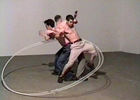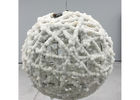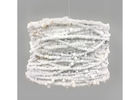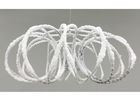Sigalit Landau
Biographie
Sigalit Landau was born in 1969 in Jerusalem (IL) and grew up in Philadelphia (US) and London (UK), among other places. She graduated with a bachelor’s degree from the Bezalel Academy of Arts and Design in Jerusalem (1990–1995). In 1993 she then studied at the New York Cooper Union School of Art and Design, where one of her teachers was Hans Haacke. After graduating from there, she spent several years in London. In 2002 she was awarded the Young Artist Award of the Israeli Ministry of Science, Culture and Sport. Participations in the 47th and 54th Biennales di Venezia (1997 and 2011) and at documenta X in Kassel (1997). Exhibitions include the Witte de With Centre for Contemporary Art (Rotterdam, NL, 1996), the Museo Reina Sofía (Madrid, ES, 2005), the Museum of Modern Art (MoMA, New York, US, 2008), the Museu d’Art Contemporani de Barcelona (MACBA, ES, 2014), and the Wiener Festwochen (AT, 2016). In 2019 the Museum der Moderne Salzburg presented a large solo exhibition of the artist’s work at both its venues under the title Salt Years. She lives and works in Tel Aviv.
Additional biography
Sigalit Landau originates from a family with old Austrian roots. Her parents only narrowly escaped the Shoah. Landau makes three-dimensional sculptural works and installations, and she also produces videos in which she herself is frequently the main protagonist. Her probably best-known video, Barbed Hula, is marked by a very sober intensity. In the year 2000, she stands naked on the beach at Tel Aviv with a barbed-wire hula-hoop circling around her waist. With every swing of her hips, the wire cuts deeper into her flesh. Her body becomes a parable for the historical suffering of the Jews and the current political crisis region of Israel, where the interests of three world religions clash. Associations with the Christian symbol of Jesus’s crown of thorns, with the barbed wire fences of the Nazi concentration camps, and the political controversial fencing-in of the Palestinian Territories are all permissible here. Landau creates powerful images of a symbolically charged political iconography. Victim and perpetration remain ambiguous. At first glance, Landau’s salt objects look aesthetically pleasing and decorative, and even kitschy. For more than fifteen years, the artist has been using the Dead Sea, an ecological resource under threat of drying out due to systematic mining of raw materials and climate change, as a kind of laboratory. She immerses everyday objects into the water of the Dead Sea, which is so salty that there is no normal sea life. These objects may be shoes, items of furniture, musical instruments, garments, fishing nets, and also wire objects made by the artist. In the summer, it takes only a few weeks for a thick layer of salt to form on their surfaces, so that Landau is here inviting a transformation into graceful, pure white, crystal objects. Salt also has symbolic and spiritual potential. The artist says that she is undertaking a “twentieth-century archeology,” and she calls her objects “memorial conceptual ready-mades.” Memory is one of her central themes. Objects, things, and materials are marked by their histories, and this makes them mean more than their decorative appearance, suggesting a hidden level of truth. Landau belongs to the generation born in Israel and influenced by the young state whose struggle for identity has become a continuous everyday reality. When the artist performs naked in her videos, this is not intended as a feminist provocation against the male gaze of commercial nakedness in advertising, the media, or fashion. The nakedness that Landau performs is existential. Her vulnerable body becomes a metaphor for integrity and injury, and for hope and fear. In Barbed Hula, you have to look more closely to see that the bloody wounds are not in fact further opened with each turn of the hoop, as the barbs are in fact pointing outward. In spite of the very direct authenticity of her actions, Landau does not permit herself to too deeply assume the role of the martyr. She manages to overcome the position of the victim in the long suffering of Jewish history. As an artist she raises political, social, humanitarian, and ecological questions that ultimately all address the theme of active participation and that all gain universal relevance. Presently Landau is working on the geopolitical project Salt Bridge, in which she presents a vision of a platform in the middle of the Dead Sea that links Israel, Jordan, and the Autonomous Palestinian Territories by means of three connected bridges. The Generali Foundation Collection holds a representative selection of the artist’s work, with the early video Three Men Hula (1999), which is a precursor of her video Barbed Hula (2000), and three salt sculptures. (Doris Leutgeb)



